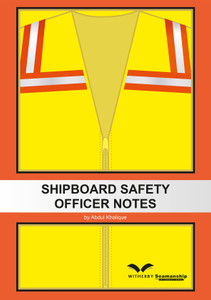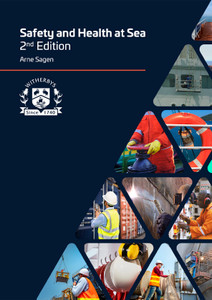
This guide highlights onboard operations that present a risk to personal safety and sets out recommended personal protective equipment (PPE) and best working practices. It looks at the roles and procedures required for effective onboard safety management and advises how to develop an onboard safety culture. The guide is illustrated with cartoons demonstrating good and bad practice.
The International Safety Management (ISM) Code requires all ships to implement a Safety Management System, to include procedures, plans, instructions and checklists for key shipboard operations. This guide complements the SMS and is designed to raise awareness of onboard hazards and promote onboard safety culture.
The book identifies the key safety practices that should be implemented on every ship, including shipboard safety management, work planning and use of personal protective equipment (PPE). It discusses a number of onboard operations, including electrical maintenance, handling shipboard chemicals, use of lifting equipment, hot work, enclosed space entry, mooring operations, cargo handling and galley work. It describes the potential hazards and sets out safeguards and best practices.
The book includes case studies relating to variety of personal injury claims. They examine the cause of each incident and the lessons to be learnt.
In many shipping companies, shipboard safety has improved greatly over the past few years. With the implementation of the International Safety Management (ISM) Code, safety awareness programmes, the routine use of safety equipment, safety training and generally the development of a safety culture have made ships safer places to live and work. However, far too many incidents, accidents, injuries and claims are still occurring.
ACCIDENTS AND THEIR CAUSES
Clearly, such accidents lead to considerable suffering on the part of the individuals involved – and their families. They also lead to insurance claims which are a drain on the already over stretched financial resources of ship owners.
The apparent cause of personal injuries is frequently attributed to ‘human error’. The true cause is often complex and involves many issues. It is the seafarers themselves, with guidance and support from the ship owner, safety advisers and legislation, who are best placed to investigate and analyse the causative factors which led to an accident. They can then implement corrective action in an effort to ensure that similar incidents do not happen again and generally assist in the reduction of personal injuries.
The word reduction is used since total elimination may not yet be a realistically viable target. But it is, nevertheless, what we should all strive for in the future.
It does not seem unreasonable to suggest that seafarers should take particular care for their own safety as well as that of their shipmates. Safety should be a priority consideration and tasks should only be attempted when all the safety implications have been fully considered and the appropriate action taken. Many accidents are the result of lapses in concentration or have seemingly minor causes. The consequences of such lapses can lead to accidents which vary in their severity, but the degree of severity is often only down to chance.
ISM CODE REQUIREMENTS
Under the International Safety Management (ISM) Code, all shipping companies are required to develop a safety and environmental policy as detailed in Section 1.4 of the Code – Functional requirements for a safety management system.
The Code, which is an International Maritime Organization (IMO) resolution, has been incorporated as Chapter IX of the Safety of Life at Sea (SOLAS) Convention and is mandatory for almost all commercial ships around the world.
Section 7 of the Code requires the Company to establish procedures, plans and instructions, including checklists as appropriate, for key shipboard operations concerning the safety of the ship. This sits alongside Section 8 which requires the Company to identify potential emergency shipboard operations and establish procedures to respond to them. This guide is not intended to fulfil those requirements in their entirety but provide a valuable complement to a ship owner’s own procedures. The manuals and procedures of each individual company Safety Management System must take precedence.
One of the listed objectives of the ISM Code is to:
‘Provide for safe practices in ship operation and a safe working environment’.
HOW TO USE THIS GUIDE
This guide details a range of safe practices which, if adopted on board ship, will help reduce the high number of accidents and injuries experienced by many seafarers. In essence, what must be developed is a safety culture. Safety and accident prevention is really a four stage process. It is necessary to:
- Identify the problem
- Provide all personnel with basic training and basic personal protective equipment
- Develop a safety culture – where safety becomes a priority consideration
- Develop accident, incident and near miss reporting systems.
BASIC SAFETY EQUIPMENT, TRAINING AND DEVELOPING THE SAFETY ETHOS
It is vital that all seafarers are provided with, and are trained in the proper use of, the correct safety equipment and personal protective equipment (PPE). This guide book attempts to identify that equipment and provide guidance on its use and the circumstances in which it should be used. Once the equipment has been provided, and seafarers know how it should be correctly used, the next step is to develop the ‘safety culture’. It is not enough to allow the management of safety to stop there – all involved must be motivated to put into practice what they have learned and to always use the correct PPE.
Developing the safety culture demands total commitment from the very top of the organisation, to drive it through the company managers, senior ship staff, officers and crew. This commitment must be a tangible one and safety and the prevention of personal injury must be elevated to become a priority factor in the operation of the company. It is vital to establish procedures, guidelines and advice to seafarers on practical means of avoiding personal injury.
The company role should be one of support and encouragement rather than one of developing more rules and regulations simply to comply with legislation. Encouragement, motivation and support of the sea staff by management will reap more benefits than increased regulation.
If they do not already do so, ship owners may wish to consider the appointment of a shore-based safety advisor who can visit ships and provide advice on safety topics. During such visits the safety advisor will be able to gain an impression of the safety awareness situation on board ship and the degree to which the safety culture has been developed. The opportunity may also be taken to provide safety training of sea staff within the context of the Safety Management System.
This guide is intended as an additional weapon in the fight against accidents – particularly personal injuries. It is not intended as an alternative to thorough training. The competency of seafarers to correctly use safety equipment and to be fully aware of onboard safety procedures is of paramount importance. With the common goal of reducing the cost of personal injury in both human and financial terms, everyone has a responsibility and a role to play.
This obviously includes you – the reader!
1. PERSONAL INJURY AND THE ROLE OF LOSS PREVENTION
Accidents and their causes
ISM Code requirements
How to use this guide
Basic safety equipment, training and developing the safety ethos
2. PERSONAL PROTECTIVE EQUIPMENT
Boilersuits
Safety shoes
Safety helmets
Ear defenders
Gloves
Goggles and eye protection
Additional personal protective equipment
3. SHIPBOARD SAFETY MANAGEMENT
Management meetings
Shipboard safety committee
Shipboard safety officer
Safety representatives
Daily work planning meetings
Weekly work planning meetings
4. WORK PLANNING AND PROCEDURES
Job allocation and equipment requirements
Detailed job procedures
Permit to work systems
Example of permit to work situation
5. WORKSHOP PRACTICES – USING MACHINE AND HAND TOOLS
Training and maintenance
Hand held power tools
Machine tools
Workshop tidiness
6. GOOD HOUSEKEEPING
Encouraging good housekeeping
Unmanned machinery spaces
Reporting deficiencies
Garbage
7. ELECTRICAL MAINTENANCE
Potential risks
Electrical equipment isolation procedures
Responding to electric shock
Storage batteries
Personal electrical equipment
8. HANDLING SHIPBOARD CHEMICALS
Sources of information for shipboard chemicals
Control of shipboard chemicals
Handling chemicals
Pollution incidents and fires involving chemicals
9. GALLEYS – CATERING AND PERSONAL HYGIENE
Personal hygiene
Injuries involving sharp objects
Galley cleanliness
Galley slips and falls
Refrigerated spaces
Galley equipment and clothing
10. LIFTING AND LIFTING APPLIANCES
Manual lifting
Lifting using mechanical means
Lifting equipment register and certification
Operator certificates
Safe working load
Effect of trim and heel
11. FIRE – PRECAUTIONS, DRILLS AND EMERGENCY PROCEDURES
Welding/hot work
Oil leaks and spills
Galley fires
Smoking
Electrical fires
Incinerators
Fire drills and exercises
Fire – emergency response
12. WELDING AND BURNING (HOT WORK)
Personal protective equipment
Welding procedures
Electric arc welding
Gas welding, burning and flame cutting
13. ACCESS, TRANSIT AND DISEMBARKING
Access to and from the ship
Transit around the ship
Preventing slips and falls
14. ENTRY INTO ENCLOSED SPACES
What is an enclosed space?
Entry procedures
Atmosphere testing
15. MOORING AND ANCHORING OPERATIONS
Anchoring
Mooring operations
Taking a tug
16. CARGO WORK – HOLDS, HATCHES AND TANKS
Maintaining safe practice
Operating hatch covers
Hold inspections
Potentially dangerous cargoes
17. OTHER AREAS NOT SPECIFICALLY COVERED
Asbestos
Passengers
Accident reporting
Dealing with an incident
18. CASE STUDIES – PERSONAL INJURY CLAIMS
Personal protective equipment
Good housekeeping
Work on electrical equipment
Welding and burning (hot work)
Entry into enclosed spaces
Cargo work – holds, hatches and tanks
19. A SAFE COURSE AHEAD
NorthStandard
NorthStandard is one of the leading providers of global marine insurance products and services across the maritime industries. Established through the merger of North P&I Club and the Standard Club in February 2023, NorthStandard brings together over 300 years of marine insurance heritage.
From headquarters in the UK and with offices throughout Europe, Asia and the Americas, NorthStandard offers a unique blend of worldwide presence and class-leading expertise across multiple specialist areas, including P&I, FD&D, War Risks, Strike & Delay, Hull and Machinery and ancillary insurance. Its Sunderland Marine and Coastal & Inland divisions also provide cover for owners’ fixed premium P&I, fishing vessels, inland waterway and coastal trading vessels and aquaculture. NorthStandard’s comprehensive local market and sector knowledge is underpinned by continuous investments in market-leading digital technologies.
NorthStandard is a leading member of the International Group of P&I Clubs (IG) and is fully committed to upholding the shared objectives of its 12 independent member clubs, which provide liability cover for approximately 90% of the world’s ocean-going tonnage.
Richard Bracken IEng, AMIMarE
Richard Bracken is a Marine Engineer who studied at nautical colleges in Cardiff, Glasgow and South Shields. He holds a UK Department of Transport Class One Certificate of Competency and sailed with Sir William Reardon Smith & Sons and Shell International Shipping before coming ashore in 1994. He sailed on general cargo ships, container ships, bulk carriers and tankers including product, Aframax and Suezmax tankers and VLCCs. He sailed in all engineering ranks from Engineer Cadet to Chief Engineer and was also an Instructional Training Officer at Shell. Richard joined North in 1994 as Loss Prevention Executive and is now Head of Underwriting (North EU) and Group Director (Underwriting) for Europe. He also leads North’s efforts to develop the Charterers and Traders programme and is part of the Management Team at North.
- Number of Pages:
- 86
- ISBN:
- 9780954201272
- Binding Format:
- Paperback
- Book Height:
- 210 mm
- Book Width:
- 147 mm
- Weight:
- 0.3 kg
- Published Date:
- August 2019
- Author:
- Richard Bracken and NorthStandard
- Preview:
- Yes
- Publication Date:
- August 2019






